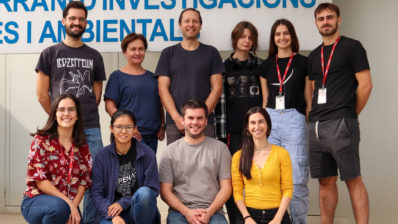On Friday December 4, the online CRG-PRBB conference – organised by the Barcelona Biomedical Research Park (PRBB) and the Centre for Genomic Regulation (CRG) – featured Denis Bourguet and Thomas Guillemaud, the two French evolutionary biologists who co-founded Peer Community In (PCI). Invited by Donate Weghorn (CRG) they explained the What, Why and How of PCI – a free recommendation process of unpublished scientific papers based on peer reviews – and how they see the future of publications.
We took the chance to ask some questions.
When and why was Peer Community In (PCI) created?
It was founded in 2017. We had (have!) a problem with the scientific publication system. Traditional journals charge a lot of money to publish and/or read the articles – and then they keep the copyright! Open Access journals allow the authors to keep the copyright and are free to read, but they still cost quite a lot money to publish with a cost ranging between 2,000 and 3,000 € per article. Preprints look like a fine solution – just posting the articles for free on the internet (on a preprint server or on an open repository). However, the problem with preprints is that there is no quality control, because they are not peer reviewed at the time they are deposited with no guarantee that they will be. What we wanted to do with PCI was to add this quality control to preprints – done by the scientific communities themselves.
“We started Peer Community In (PCI) to add a quality control to preprints, done by the scientific communities themselves”
Denis Bourguet and Thomas Guillemaud
How does it work?
When you post a preprint in a preprint server, for example bioRxiv, you can also send it for evaluation to a PCI, for example PCI Genomics. Here a recommender – a figure similar to an associate editor in a traditional journal – can decide to handle it and, if so, will find at least two reviewers. As with ‘traditional’ peer review, their reports will lead the recommender to a rejection, to ask the authors to revise their preprint or to accept it (possibly after several rounds of reviews). In this latter case, the recommender will write a recommendation text. This text, the reviews and all the editorial correspondence is published in the website of the corresponding PCI, so everything is transparent. The evaluation/recommendation process is made by scientists for scientists on a voluntary basis. Hence, the whole process is free – no payments for having your paper reviewed or recommended, and no payments to recommenders or reviewers either. The PCI recommendations can also be read by any user at no cost.
So there’s no cost whatsoever to the process?
There are some costs to develop/improve the websites, to host them, to subscribe to services like Crossref, but if the processing charge for publishing in open access in a traditional journal costs 2,000 to 3,000€, we estimate that the cost for PCI, at equilibrium, would be around 60€ per article! And these very low costs can be covered by public institutions as they currently are.
Who chooses the recommenders?
New recommenders are nominated by current recommenders and approved by the Managing Board of the specific PCI. If you are interested in becoming a recommender, please contact a current recommender in your field!
And the reviewers, are they anonymous?
We give them the choice, because there are pros and cons to reveal your name… about 50% choose to sign their review.
What happens to the manuscript once ‘accepted’?
The final ‘recommended’ version of the article is posted again in the preprint server with indications that the preprint has been peer-reviewed and recommended by the PCI. If the authors choose, it can then be sent to a journal for submission. Indeed, the PCIs do not publish the preprints they recommend – they do not generate a version of record with a specific DOI. Hence, having gone through PCI does not prevent you from publishing it later in a traditional journal! In fact, about 2/3 of our recommended articles end up being published in an indexed scientific journal. Some of them even use our reviews to speed up their editorial decision, which makes the evaluation process faster and more likely to have it accepted. But that is not really our aim; our wish was to provide an alternative to journals, notably to for-profit journals that require authors to pay several thousands of euros for open access. Today 1/3 of the authors already prefer to keep their recommended preprints outside journals because they consider that a publication in a journal is not necessary.
What is the future you imagine for scientific publication?
We can imagine a three layers system. First, all manuscripts would be posted as preprints in the existing servers before any evaluation. Then – the second layer – they could be openly reviewed by scientific communities, via PCI or other similar initiatives like Reviews Commons, Peer J, PreReview, Peerage of Science… The third layer would be the endorsement, based on published reviews, by validation platforms such as PCI or journals.







